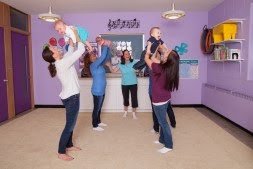Parenting Tip: Move baby high, low, and in-between!
Why?
Allowing a child to experience being moved in many different directions (for example, being swung down low, then moved up to dance up high) is an essential part of the learning process.
Neural pathways in the brain are developed through experience, stimulation, and interaction. Varied experiences will increase the number of these neural pathways.
Movement and sensory awareness are the primary ways young children learn about themselves, and their world.
A child moves up & down before learning the words 'up' and 'down.' By labeling our movements while swooping low, and dancing up high, we help babies make connections between what they are feeling, and the words they are hearing.
How?
Look at the e-book Butterfly, Butterfly, with baby! Enjoy flying your 'hand butterflies' all around, and landing on baby, with each page :) What if you used a butterfly toy from home? or maybe a scarf, or other, colorful cloth?
Try this High & Low Instruments game!
As you enjoy your new home CD, keep an ear open for high sounds & low sounds. Take each opportunity to share those words with baby, and add a movement game, or instrument/vocal play to add to baby's experience with the music!
Want to Learn More?
On our blog - learn more about the importance of introducing baby to opposite concepts!
Kindermusik 7-Year Continuum: As a baby, your child counts on you to move her body in a variety of ways – so that she knows what is possible. In Kindermusik toddler classes, your child will use his vocabulary of movement experiences to move his own body to the music – movement is how toddlers learn best! As a preschooler, your child will begin to use movement to express stories and music, using her own imagination. In Young Child classes, your big kid makes use of the coordination & muscle control he's been developing over the years, as he holds glockenspiel mallets, and plays notes on his glockenspiel using just the right amount of force. Small, quiet movements now become a lighter touch with the mallets, as big, loud movements become a heavier touch, producing more instrumental sound.









